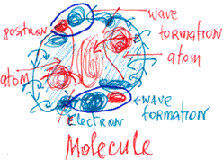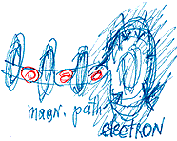Chapter 5 - Wave Theory and
the Electron
(Continued —
Page 2)
Printer-Friendly Version
From beautiful pictures obtained of the sun, we see that
energetic matter expelled from the star moves in the form
of a swirl (picture below). This energetic path is probably
mainly composed of magnetic loops, because the energetic loops
that look like dark circles on the surface of the sun are
composed of invisible energetic (dark) matter.

Before it is sucked into the Kerr swirl, the magnetic path
creates a swirling cloud. Perhaps, in the atom, this formation
is the electron (a moving cloud). The Kerr swirl, which behaves
like a black hole, can swallow only small amounts of energy.
Excess energy is concentrated near the mouth of the swirl
and grows, achieving more mobility and space. In the atom,
the electron cloud appears to be more independent and jumps
to a higher orbit. Perhaps, rather than actually jumping to
a higher orbit, the electron cloud enlarges its space enough
to come in contact with the higher orbit.
The enlargement of the electron cloud’s space, caused
by the addition of energy,  enables
it to form relationships with swirls of other atoms. Because
it is magnetic, it connects with positron loops near Schwarzschild
swirls and creates a small photon-like wave (picture to the
right). The cloud, however, does not lose contact with the
matter from which it originated. enables
it to form relationships with swirls of other atoms. Because
it is magnetic, it connects with positron loops near Schwarzschild
swirls and creates a small photon-like wave (picture to the
right). The cloud, however, does not lose contact with the
matter from which it originated.
Because the electron cloud belongs to the magnetic path (picture
below), it moves in  a
perpendicular path from north to south or south to north,
or around the energetic swirl (proton) - but only in the direction
of the swirl’s rotation, west to east. This is the rotation
of atomic energy formations. a
perpendicular path from north to south or south to north,
or around the energetic swirl (proton) - but only in the direction
of the swirl’s rotation, west to east. This is the rotation
of atomic energy formations.
By adding more energy, the electron cloud can separate itself
from its wave and become a high-energy independent magnetic
loop (electron), flowing between atoms in the energetic path.
Once the atom from which the electron originated creates another
cloud of excess energy, the lost electron cannot return to
its original wave. If it is connected to magnetic paths, the
electron can jump orbits when energy is added, and return
to its original size when energy is lost. Every atom has its
specific energy level, space and time. When energy is added,
their orbits cannot exceed the energy level of the original
wave. Excess energy is expelled in the form of photons bearing
the characteristics of the atom releasing them.
Back to
Top
Dr. Chaim Tejman, Copyright©
2001. All rights reserved.
[Index]
[Introduction]
[Summary] [Wave
Formation] [Photons] [Gravitation]
[Time]
[Atoms] [Life]
[Cancer] [Fundamental
Force] [Gender/Why Sex?]
[Sexual Reproduction]
[Schrodinger & Heisenberg]
[Creation] [Supernova]
[Dark
Matter & Astronomy] [Speed
of Light] [Cloud Formations]
[Natural Disasters] [Global
Warming] [Thermodynamics]
[Backward Time] [Quantum
Mechanics] [Compton Effect]
[Equations] [Predictions]
[Academic Correspondences] [Contact]
[Links] [Mysteries] |